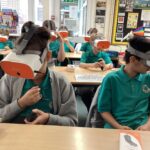Participants in the Team Englewood program on Chicago’s South Side use virtual reality headsets for job training. Photo: Justin Kaufmann/Axios
A training program for recently incarcerated people is using virtual reality to teach job readiness skills.
Why it matters: Statistics show that people recently out of prison have a harder time finding work, which can lead them back to prison, restarting generational cycles of poverty and crime.
- In 2016, 89% of new convictions in Illinois were reoffenders headed back to prison.
The big picture: Teamwork Englewood, a job readiness program focused on reentry, is trying to buck that trend by leaning into virtual reality (VR).
What they’re saying: „It’s hard for guys to get out of jail and go right into the workforce,“ Team Englewood’s Mark Mitchell tells Axios. „It’s almost like the system is designed for them to go back. That’s where this technology comes in.“
How it works: Participants use VR headsets to simulate real-world jobs at warehouses and construction sites. They learn skills such as using power tools or operating cranes.
- The three-week program includes 19 hours of VR-based training, while also offering mock interviews and resume-building workshops.
Yes, but: It’s competitive. On the day Axios visited the office, over 100 people were there to apply. Fewer than 15 are accepted.
- The program is tailored to those with little or no work history, especially individuals who have served longer prison terms.
- „We’ve had people in the program who have done 25 years in prison and missed the whole wave of technology,“ Team Englewood’s LaShawn Evans tells Axios. „With this program, they’ve become some of the best people we’ve placed.“
Mark Mitchell talks to potential applicants at the Team Englewood offices on Chicago’s South Side. Photo: Justin Kaufmann/Axios
Zoom in: According to Mitchell, the clock is ticking the minute someone gets out of jail, which is why VR technology helps speed up the process.
- „The stats show that work ethic starts to dissipate if unemployment persists beyond 90 days, which is usually how long job training programs are,“ Mitchell says. „We gotta get them to work faster.“
Reality check: The technology is also designed to build confidence. Mitchell says the big issue is that newly released people quit their new jobs within days.
- „During the pandemic, we found out that around 19% of our people were abandoning their jobs on day one,“ Mitchell says. „It was an intimidation factor. So they quit and head back to the streets and most likely back to jail.“
- Mitchell says with the help of VR, the 30-day job retention rate with his participants has climbed to 80%, as opposed to temp agency hires, which hover around 20%.
Plus: Unlike other job readiness programs, Team Englewood pays participants $1,000 for VR training.
Zoom out: Team Englewood partners with the workplace training organization Transfr to acquire the VR headsets and support. Transfr, which has been doing VR training since 2017, uses the technology in prisons as well as juvenile detention centers around the country.
- „The technology that we use today didn’t exist 10 years ago,“ Transfr’s Kate Kimmer tells Axios. „This idea that I could put a human in the device is incredible. The demand is there, the need is there.“
The state of play: To pay for the program, Team Englewood receives funding from both the city and the state, plus private grants.
Between the lines: Mitchell recognizes the program could be in jeopardy with various federal and local budget crunches. „Without funding, we’d be dead in the water.“
The bottom line: Mitchell believes that his program can break generational cycles of incarceration and poverty.
- „This program can change the whole city,“ Mitchell says. „This can stop people from getting robbed, getting killed.“
Quelle:


